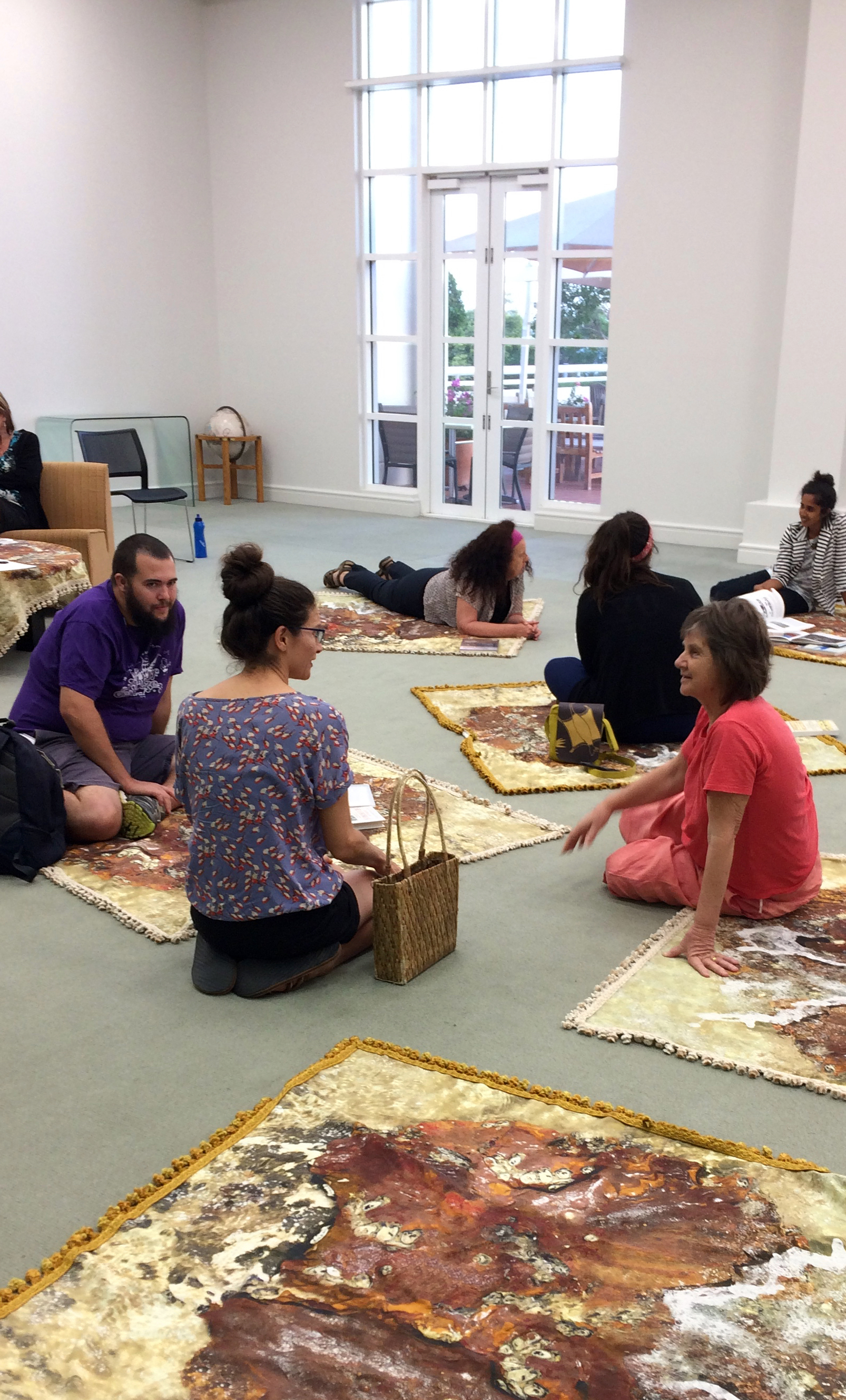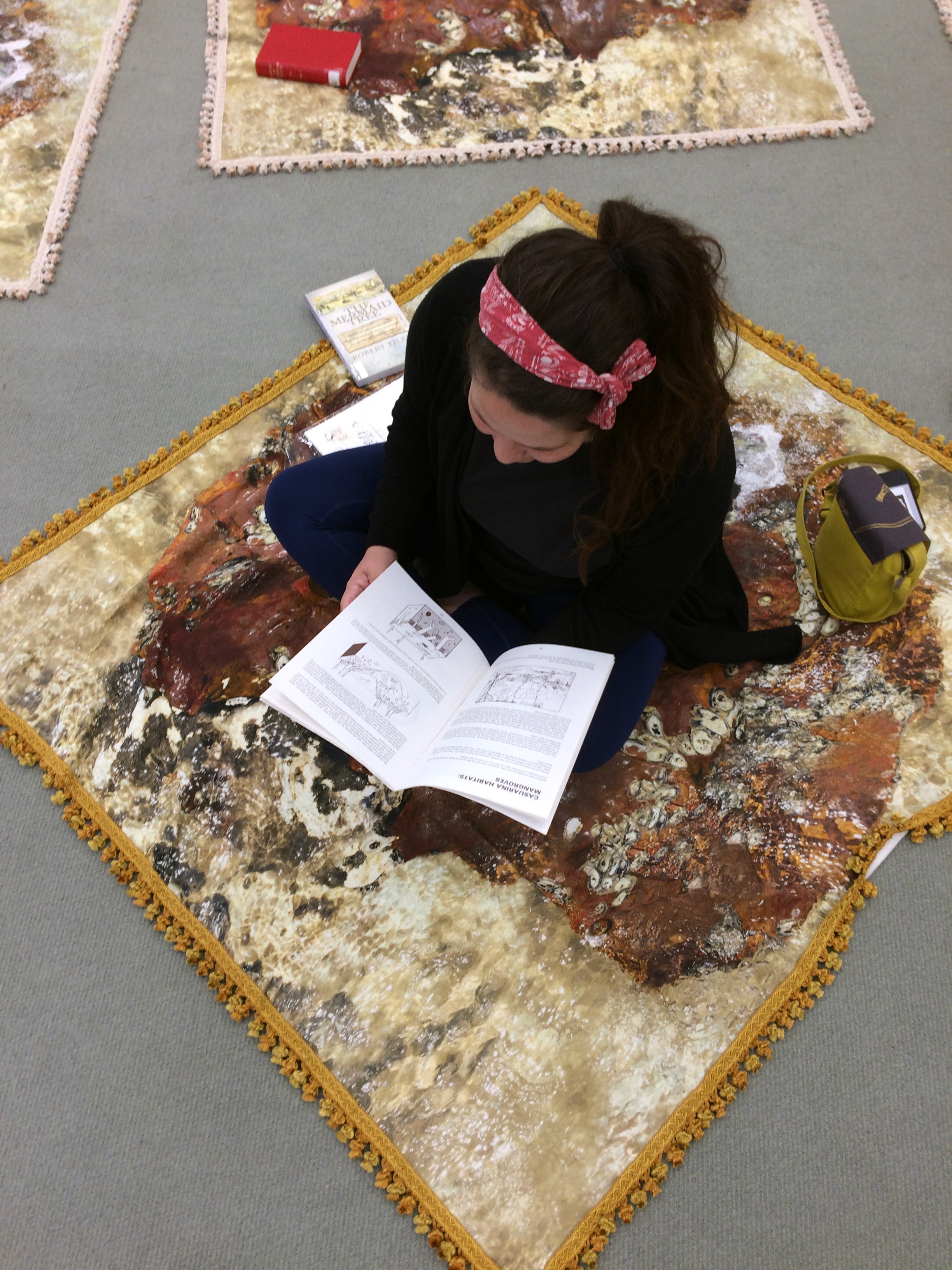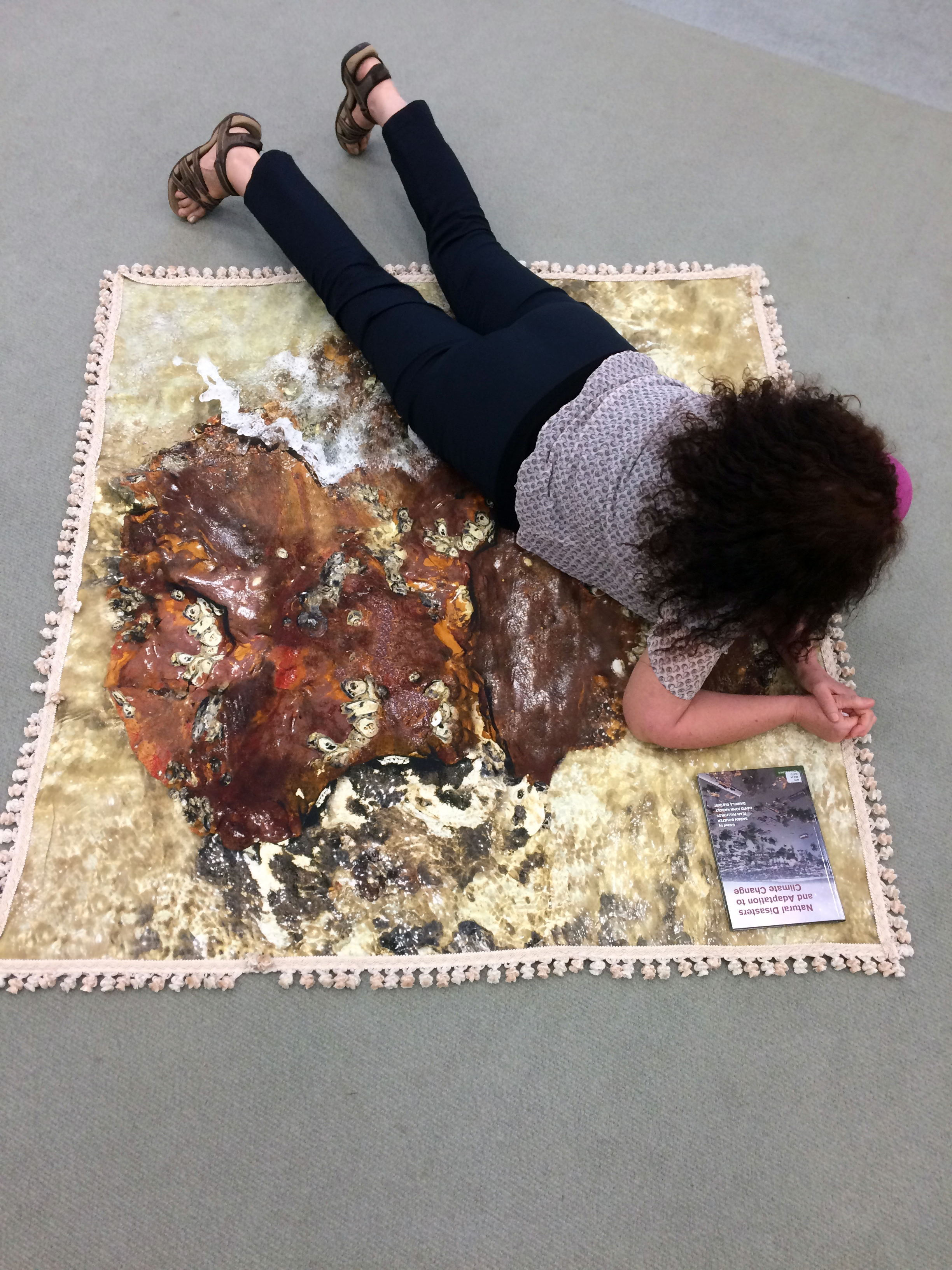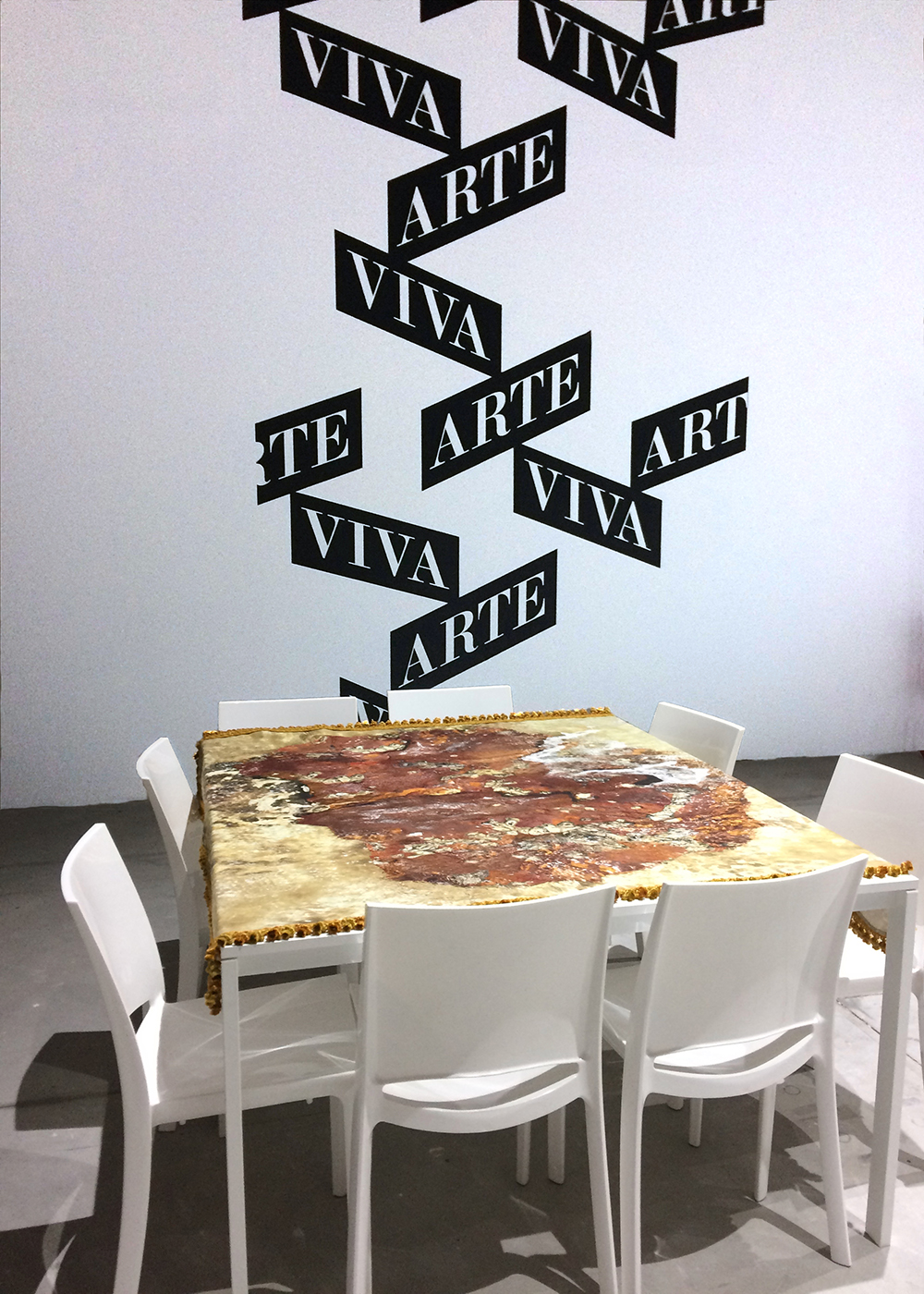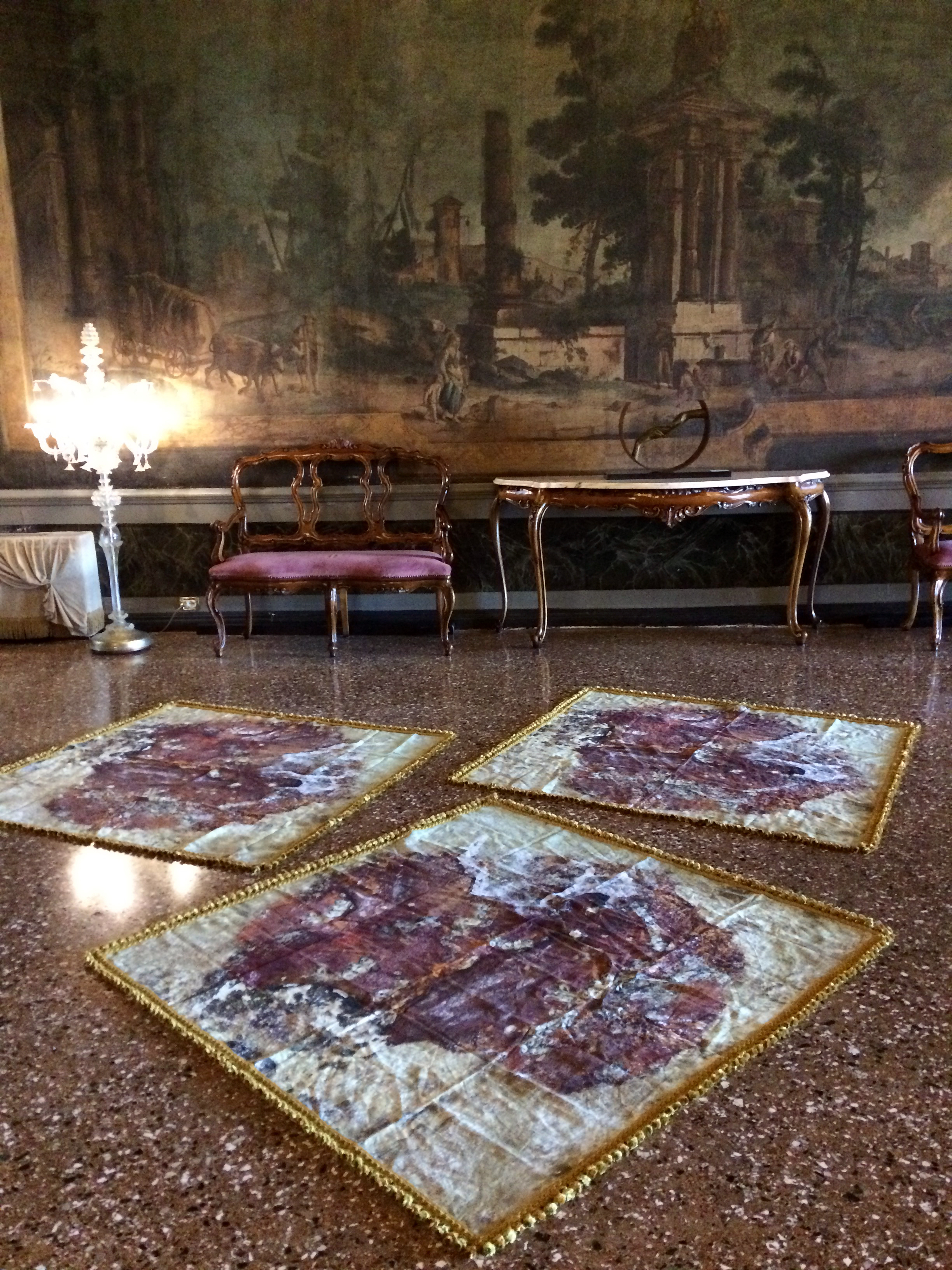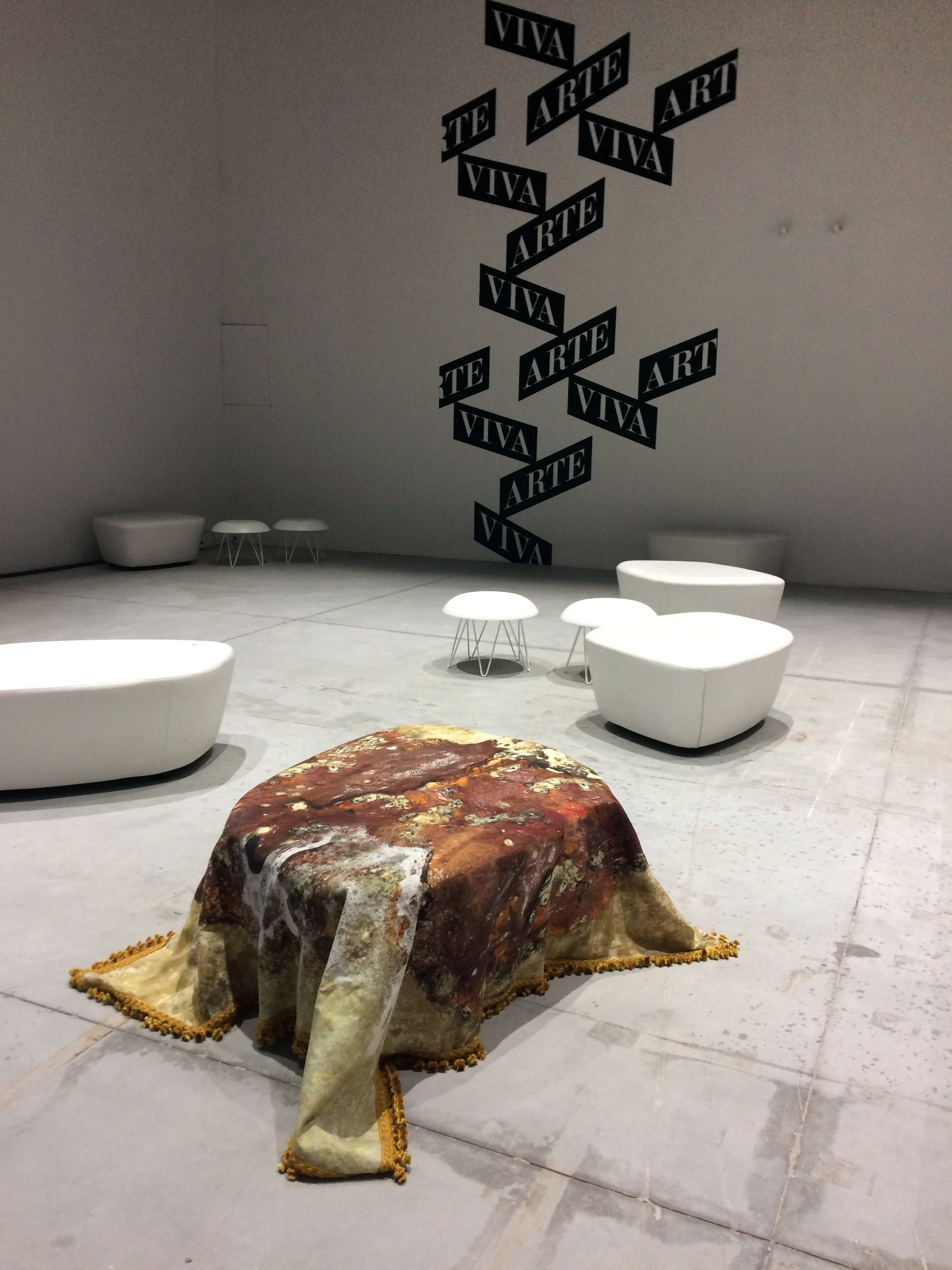Rocksitting Place Mats
Sarah Pirrie, Hill in Rock out, 2020 (digital still), digital video.
The juxtaposition in and out of two historical gestures, an 1870 photograph of Fort Hill and the commemorative flagpole of the Darwin Rocksitters Club allow a new materialist comparison to be made. Each exists within time valued systems of governance including geological, cyclonic, and the social times of people’s beliefs and attitudes.
The photographic composition of Captain Samuel Sweet, Captain of the Gulnare, which you can see at anchor in the distance, was taken to commemorate the advance party of colonisers working on the construction of the Overland Telegraph in 1870. The British empire and the South Australian Government followed Edward Gibbon Wakefield’s empire building methodology ensuring the directive to “establish settlements on the waste land of the new country”[1]. This mindset gave no consideration to existing Indigenous uses and values of land and marine regions. Darriba Nungalinya and Lee Point Lookout were important cultural sites long before the Gulnare made anchor.
Darwin rocksitting could be described as an absurdist endurance game invented in 1974, emphasising libertarian larrikins, drinking and aspirational claiming of place. Sweets’ photograph and the establishment of the Darwin Rocksitters Club are over one hundred years apart. Both highlight aspirational worldviews of nation building or as in the case of post cyclone Darwin Rocksitters Club, nation re-building. Both actions communicate a contrast between the human and non-human geological actor of the coastline and meteorological monsoonal conditions. Darwin coastline including Fort Hill and East Point is a Cretaceous stratum of sedimentary rocks and cliffs. It has a dominating presence in colour and form and reflects years of stratigraphic compression that continues to be impacted by tidal events today.
Durational time is express in many different ways here. There is the immediacy of the photo countered to the legacy of colonisation and impact of development. Then there is the endurance game of rock-sitting as they pit themselves against geological and biological time. We are told that in 1986 the rocky outcrop that was used for rock sitting was destroyed by lightning when the flagpole was struck. A symbolic tool, the flagpole here is both promoter and destroyer. Finally, there is the enduring Larrakia ancestral life and present-day sacred sites, Indigenous knowledge systems of time are a complex enmeshment of past and present which accounts for non-human and human histories that fully acknowledges seasons and coastal marine environment.
The Rocksitting Place-mats were produced for Coastal Links, as part of 2017 Creative Residency with Northern Territory Library. As a facsimile of the destroyed East Point rock during high tide, Rocksitting Place-mats are an un-claiming apparatus, speculative in their subjectivity and flexible objecthood. They are a creative response to dispossession and appropriation of lands and sea. They speak to the vitality of rocks and mineral formations, as things that are relational to the living and not simply something to be removed or used as a pedestal of occupancy and possession. While the image is in action (tidal waves encroaching) it is itself static reliant on other forces (human & nonhuman) to find shape and form. Movable and reshaping the Rocksitting Place-mats form to the surface they are placed on or air current they flaps in. This is an important transgression for the still image. Like a backdrop in a portraiture studio it provides the sitter with context of a geological place, that is alive to its mutability; moving, folding, reshaping so that the fixed aspect of the work (the image) may be changed, distorted in infinite composition. Ultimately this is a mat to be used to tread more lightly on the planet. To consider the multiplicities of time and place as relative to sustainability.
[1] (Mills, R. C. (1974). The colonization of Australia (1829-42): the Wakefield experiment in empire building (Facsim. ed.). Sydney: Sydney University Press. p. 92
The photographic composition of Captain Samuel Sweet, Captain of the Gulnare, which you can see at anchor in the distance, was taken to commemorate the advance party of colonisers working on the construction of the Overland Telegraph in 1870. The British empire and the South Australian Government followed Edward Gibbon Wakefield’s empire building methodology ensuring the directive to “establish settlements on the waste land of the new country”[1]. This mindset gave no consideration to existing Indigenous uses and values of land and marine regions. Darriba Nungalinya and Lee Point Lookout were important cultural sites long before the Gulnare made anchor.
Darwin rocksitting could be described as an absurdist endurance game invented in 1974, emphasising libertarian larrikins, drinking and aspirational claiming of place. Sweets’ photograph and the establishment of the Darwin Rocksitters Club are over one hundred years apart. Both highlight aspirational worldviews of nation building or as in the case of post cyclone Darwin Rocksitters Club, nation re-building. Both actions communicate a contrast between the human and non-human geological actor of the coastline and meteorological monsoonal conditions. Darwin coastline including Fort Hill and East Point is a Cretaceous stratum of sedimentary rocks and cliffs. It has a dominating presence in colour and form and reflects years of stratigraphic compression that continues to be impacted by tidal events today.
Durational time is express in many different ways here. There is the immediacy of the photo countered to the legacy of colonisation and impact of development. Then there is the endurance game of rock-sitting as they pit themselves against geological and biological time. We are told that in 1986 the rocky outcrop that was used for rock sitting was destroyed by lightning when the flagpole was struck. A symbolic tool, the flagpole here is both promoter and destroyer. Finally, there is the enduring Larrakia ancestral life and present-day sacred sites, Indigenous knowledge systems of time are a complex enmeshment of past and present which accounts for non-human and human histories that fully acknowledges seasons and coastal marine environment.
The Rocksitting Place-mats were produced for Coastal Links, as part of 2017 Creative Residency with Northern Territory Library. As a facsimile of the destroyed East Point rock during high tide, Rocksitting Place-mats are an un-claiming apparatus, speculative in their subjectivity and flexible objecthood. They are a creative response to dispossession and appropriation of lands and sea. They speak to the vitality of rocks and mineral formations, as things that are relational to the living and not simply something to be removed or used as a pedestal of occupancy and possession. While the image is in action (tidal waves encroaching) it is itself static reliant on other forces (human & nonhuman) to find shape and form. Movable and reshaping the Rocksitting Place-mats form to the surface they are placed on or air current they flaps in. This is an important transgression for the still image. Like a backdrop in a portraiture studio it provides the sitter with context of a geological place, that is alive to its mutability; moving, folding, reshaping so that the fixed aspect of the work (the image) may be changed, distorted in infinite composition. Ultimately this is a mat to be used to tread more lightly on the planet. To consider the multiplicities of time and place as relative to sustainability.
[1] (Mills, R. C. (1974). The colonization of Australia (1829-42): the Wakefield experiment in empire building (Facsim. ed.). Sydney: Sydney University Press. p. 92
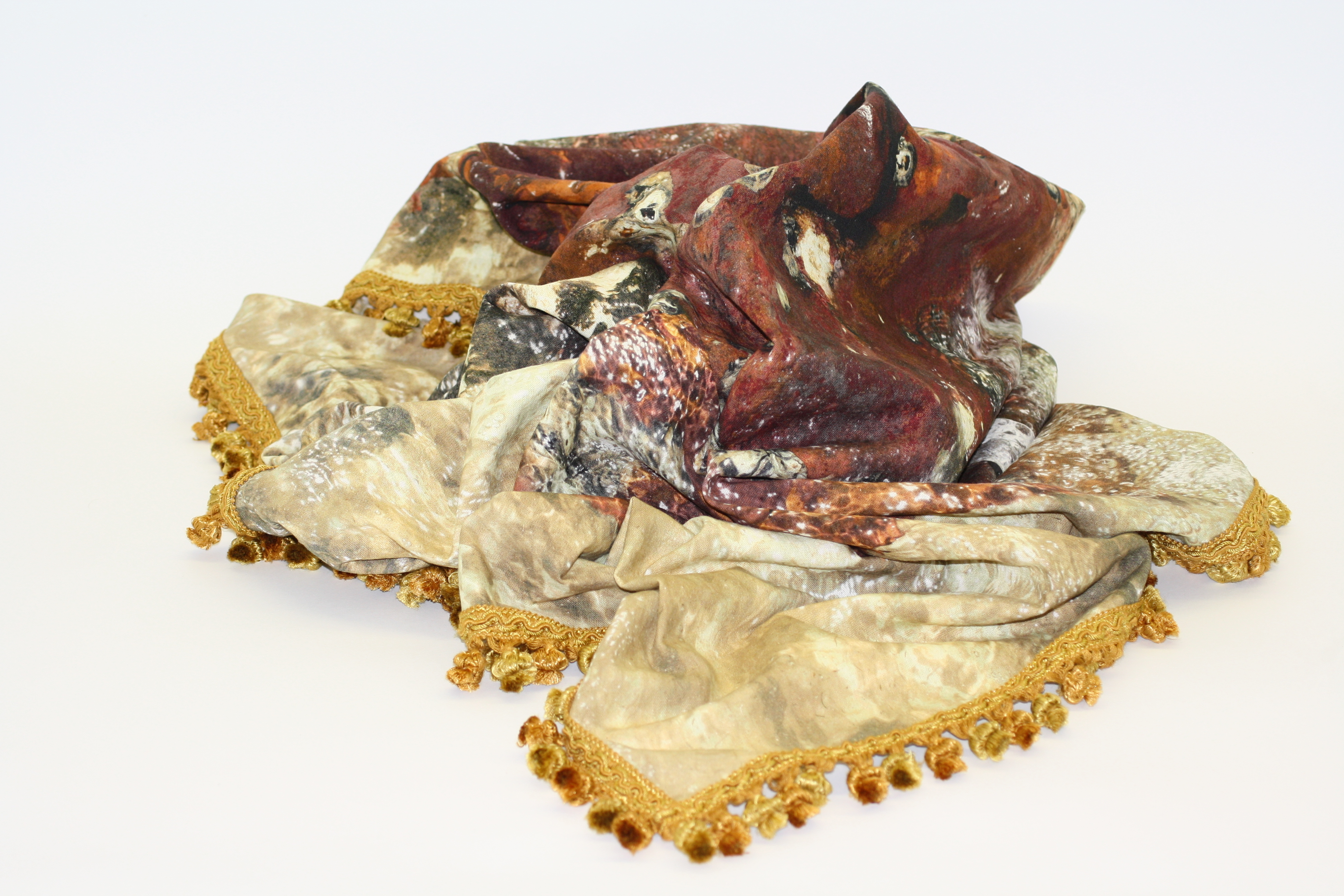
Coastal Links: Rocksitting Place mats
invigilate. v. past participle of invigilare "watch over, be watchful, be devoted," from in- "in" (see in- (2)) + vigilare (see vigil)
“Larrakia and Englishmen gazed in mutual incomprehension as Mermaid ghosted away under light winds.”
Powell, A. (2010). Northern voyagers : Australia's monsoon coast in maritime history. North Melbourne, Vic. :Australian Scholarly Publishing.
1819
“In 1819 the 84-ton teak-built cutter, a 56 feet long ship named the Mermaid cruised off Casuarina Beach. Captain Phillip Parker King wrote in his book , Narrative of a Survey, Vol. I about the ‘deep red-coloured cliffs’ of the outer harbour and the presence of ‘sixteen or twenty’ Aborigines on the beach, ‘engaged in fishing, or perhaps in watching our movements” Powell, A. (2010). Northern voyagers : Australia's monsoon coast in maritime history. North Melbourne, Vic. :Australian Scholarly Publishing p. 67. Footnote 57, King, Narrative of a Survey, Vol. I, pp. 270
invigilate. v. past participle of invigilare "watch over, be watchful, be devoted," from in- "in" (see in- (2)) + vigilare (see vigil)
“Larrakia and Englishmen gazed in mutual incomprehension as Mermaid ghosted away under light winds.”
Powell, A. (2010). Northern voyagers : Australia's monsoon coast in maritime history. North Melbourne, Vic. :Australian Scholarly Publishing.
1819
“In 1819 the 84-ton teak-built cutter, a 56 feet long ship named the Mermaid cruised off Casuarina Beach. Captain Phillip Parker King wrote in his book , Narrative of a Survey, Vol. I about the ‘deep red-coloured cliffs’ of the outer harbour and the presence of ‘sixteen or twenty’ Aborigines on the beach, ‘engaged in fishing, or perhaps in watching our movements” Powell, A. (2010). Northern voyagers : Australia's monsoon coast in maritime history. North Melbourne, Vic. :Australian Scholarly Publishing p. 67. Footnote 57, King, Narrative of a Survey, Vol. I, pp. 270
Rocksitters. Darwin, Australian activity involving competitive beer consumption on
one tidally defined rock at East Point Reserve: Darwin Rocksitter’s Club https://www.rocksitters.com.au/
1974
May
Rocksitting started
December
Cyclone Tracey hit Darwin
![]()
![]()
May
Rocksitting started
December
Cyclone Tracey hit Darwin


1977
Darwin Rocksitter’s Club
October 1977 the first challenge to the world is thrown down with a 5 day marathon sit Rocksitters. (2009). Darwin Rocksitters Club: Milestones. Retrieved from http://www.rocksitters.com.au/milestones/
Also in 1977-1978
The major state powers kept by the Commonwealth in the NT include Aboriginal land rights, the mining of uranium and other prescribed substances, industrial relations and control of Commonwealth national parks.
Culture, D. o. T. a. (2016). Records 1986. NT Cabinet records. Retrieved from https://dtc.nt.gov.au/arts-and-museums/northern-territory-archives-service/cabinet-records/1977-records
Darwin Rocksitter’s Club
October 1977 the first challenge to the world is thrown down with a 5 day marathon sit Rocksitters. (2009). Darwin Rocksitters Club: Milestones. Retrieved from http://www.rocksitters.com.au/milestones/
Also in 1977-1978
The Commonwealth
Government began transferring executive powers to the Legislative Assembly in
preparation for Northern Territory (NT) self-government.
On 1 January 1977, the NT public
service was created and administrative powers relating to a number of state
functions such as police, fire brigades, local government, and correctional
services were transferred from the Commonwealth to the NT.
Functions such as health and the Supreme Court were progressively transferred to
the Northern Territory Government.
The Fraser Federal Government
enacted the Northern Territory (Self Government) Act 1978 (Commonwealth) the NT
was established under the Crown with limited state-like powers with effect from
1 July 1978.
The major state powers kept by the Commonwealth in the NT include Aboriginal land rights, the mining of uranium and other prescribed substances, industrial relations and control of Commonwealth national parks.
Culture, D. o. T. a. (2016). Records 1986. NT Cabinet records. Retrieved from https://dtc.nt.gov.au/arts-and-museums/northern-territory-archives-service/cabinet-records/1977-records
Anthropogenic adj. an·thro·po·gen·ic -pə-ˈje-nik :
of, relating to, or resulting from the influence of human beings on nature
1986
Rocksitters are devastated as lighting destroys the sacred rockRocksitters. (2009). Darwin Rocksitters Club: Milestones. Retrieved from http://www.rocksitters.com.au/milestones/
Also in 1986
Culture, D. o. T. a. (2016).Records 1986. NT Cabinet records. Retrieved from https://dtc.nt.gov.au/arts-and-museums/northern-territory-archives-service/cabinet-records/records-1986/about-1986-records
1986
Rocksitters are devastated as lighting destroys the sacred rockRocksitters. (2009). Darwin Rocksitters Club: Milestones. Retrieved from http://www.rocksitters.com.au/milestones/
Also in 1986
Landscaping plans for the low lying land behind Vesteys Beach in Darwin
were released for public consultation in 1986.
Hon IL Tuxworth resigned as Chief Minister 14 May 1986 and Hon SP Hatton sworn in as
Chief Minister 15 May 1986
The NT had the youngest age profile in Australia with median age in
1986 of 25.7 years.
Mrs Lindy Chamberlain was released
from prison in Darwin in February 1986
A nuclear power plant at the Ukraine town of Chernobyl, exploded in
April 1986 causing widespread radioactive contamination of the region. Hundreds
of thousands of people were displaced by the disaster as the Soviet Union
evacuated and closed off the surrounding area within 18 miles of the plant.
Contaminated dust and air from Chernobyl blew across parts of Europe.
Culture, D. o. T. a. (2016).Records 1986. NT Cabinet records. Retrieved from https://dtc.nt.gov.au/arts-and-museums/northern-territory-archives-service/cabinet-records/records-1986/about-1986-records
